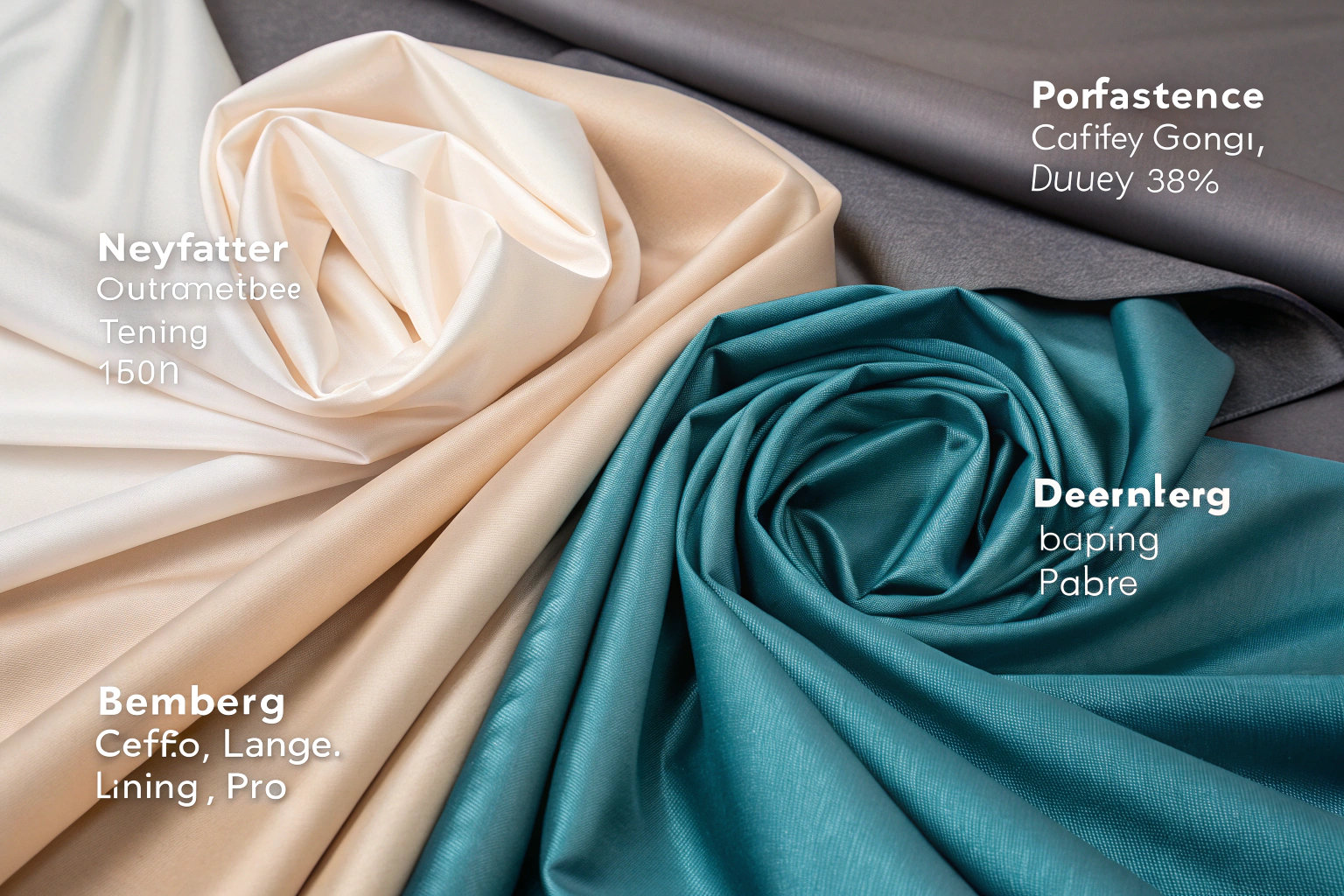As a fabric manufacturer with over two decades in the textile hub of Keqiao, I've seen countless brands struggle with lining selection. The wrong choice can sabotage an otherwise perfect garment. You're not just picking a fabric; you're choosing the hidden engine that determines comfort, durability, and silhouette. This question is crucial for designers and brands who want their creations to feel as good as they look.
The "best" lining isn't a single fabric but the right fabric for your specific garment and customer. Polyester taffeta offers durable, cost-effective performance. Acetate delivers elegant drape and aesthetic appeal at a mid-range price. Bemberg™ cupro provides top-tier, breathable luxury with a silky touch. Your final choice depends on balancing budget, desired hand feel, breathability, and sustainability goals for your collection.
Let's break down this complex decision. We will explore the unique strengths and weaknesses of each contender. By the end, you'll have a clear framework to select the perfect lining that elevates your designs and satisfies your customers.
What are the key properties of a good lining fabric?
A great lining must perform its job invisibly. It should make the garment easier to put on, improve its hang, and protect the outer fabric from sweat and wear. When a lining fails, it can lead to customer returns and damage to your brand's reputation. The core properties are often interlinked, and a weakness in one area can be a deal-breaker.
The key properties of a good lining fabric are breathability, durability, a smooth hand feel, static resistance, and colorfastness. It must allow skin to breathe, withstand the friction of movement, feel pleasant against the skin, not cling uncomfortably, and retain its color without bleeding onto the main garment. These factors together ensure the lining enhances the wearer's comfort and the garment's longevity.
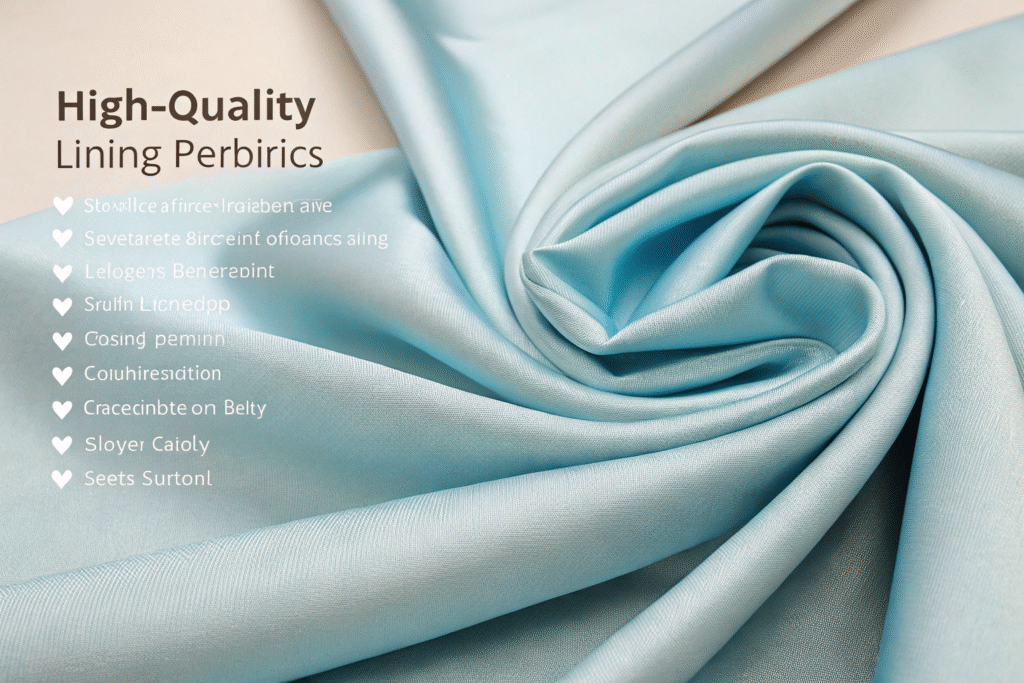
How does breathability impact wearer comfort?
Breathability is the fabric's ability to allow air to circulate and moisture vapor (like sweat) to escape. A non-breathable lining traps heat and humidity, making the garment feel sticky and uncomfortable. This is especially critical for lined jackets, dresses, and formal wear. Natural and semi-synthetic fibers like Bemberg cupro, which is made from cotton linter, are inherently more breathable than most synthetics. They wick moisture away from the body, keeping the wearer dry and comfortable throughout the day. For performance outerwear, look for specialized moisture-wicking fabrics that are engineered for high breathability.
Why is durability and strength non-negotiable?
Durability refers to a lining's ability to withstand abrasion and repeated stress without tearing or pilling. The lining experiences constant friction from movement against the outer fabric and the body. A weak lining will tear at the seams or under the arms, ruining the garment. Strength is measured by tensile and tear strength tests. Polyester taffeta is renowned for its high strength and resistance to abrasion, making it a workhorse for bags, jackets, and heavy-use items. It's crucial to check the fabric's martindale abrasion test results, especially for items that will see frequent use, to ensure the lining can handle the intended lifestyle of the garment.
How does polyester taffeta perform as a lining?
Polyester taffeta is the undisputed champion of the mass market for good reason. It's the reliable, budget-friendly option that gets the job done. I've worked with countless sportswear brands and bag manufacturers who prioritize function and cost, and polyester taffeta is often their first choice. It provides a solid foundation without breaking the bank.
Polyester taffeta performs as a highly durable, cost-effective, and moisture-resistant lining. Its tight plain weave and synthetic composition make it strong, shrink-resistant, and easy to care for. However, it lacks the breathability and luxurious feel of natural fiber linings. It's best suited for applications where strength and budget are primary concerns, such as in outerwear, bags, and budget-conscious fashion lines.
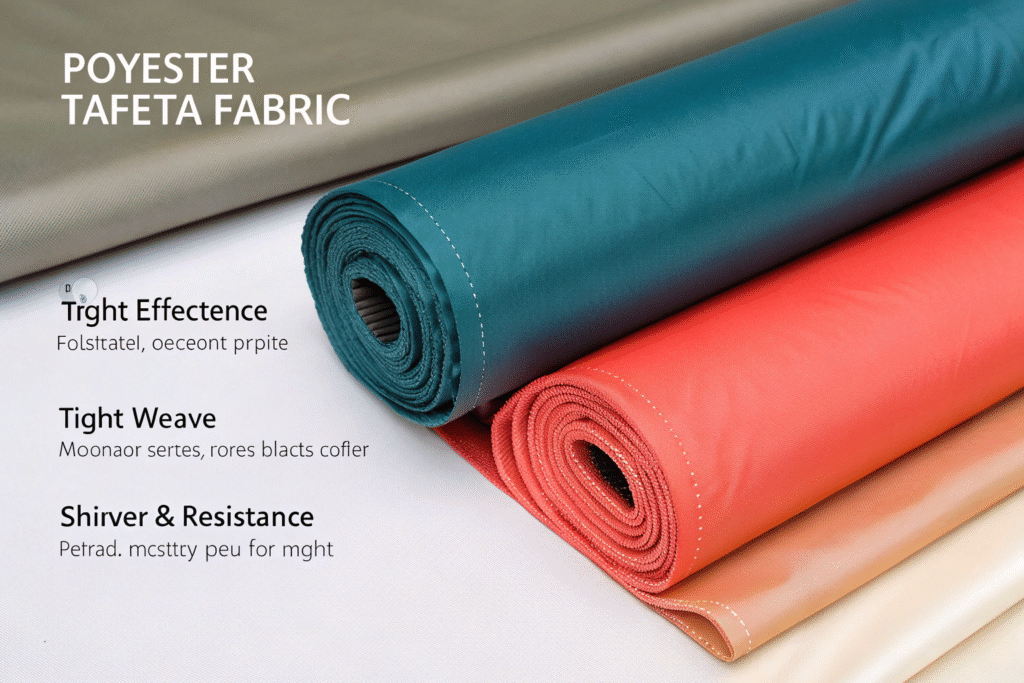
What are the advantages of choosing polyester taffeta?
The advantages of polyester taffeta are significant, especially for large-scale production. Its primary benefit is low cost, making it accessible for high-volume orders. Secondly, its high tensile strength means it can handle rough use without tearing. Third, it has excellent moisture resistance, so it dries quickly and won't absorb water easily. Furthermore, it holds color well, offering vibrant color options for designers. Finally, it's very easy to maintain, as it's wrinkle-resistant and can withstand machine washing, which aligns well with the needs of the fast fashion industry.
Where does polyester taffeta fall short?
Despite its strengths, polyester taffeta has notable drawbacks. The most common complaint is its lack of breathability. It can feel plasticky and trap body heat, leading to discomfort during extended wear. It is also prone to building up static electricity, causing skirts and dresses to cling. From a sustainability perspective, as a petroleum-based product, it is less eco-friendly than renewable alternatives unless you specifically source recycled polyester linings. Its hand feel is not as soft or luxurious as acetate or cupro, which can make a garment feel cheaper.
Is acetate the right choice for a luxurious drape?
When brands approach us for linings that make a dress or skirt flow beautifully, acetate is a frequent topic. It bridges the gap between economy and luxury, offering a beautiful drape and sheen that mimics silk without the same high cost. It's for the designer who wants aesthetic appeal and a premium feel on a realistic budget.
Acetate is an excellent choice when a luxurious, silky drape and aesthetic appeal are the top priorities. It provides a beautiful luster and fluid movement that enhances the hang of dresses, skirts, and linings. However, it has limitations in durability and moisture absorption. It is best used in garments that won't require frequent washing and where breathability is less critical than visual effect.
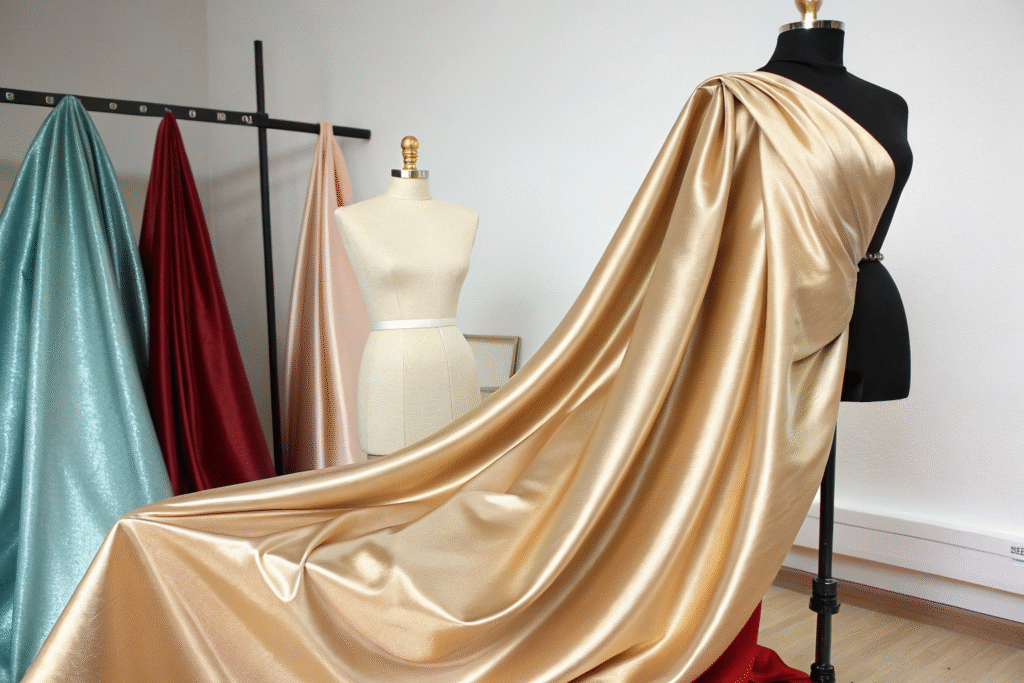
What makes acetate a popular lining for drape?
Acetate is popular for its drape because of its unique fiber properties. It is a semi-synthetic fiber made from cellulose, which gives it a relatively heavy and fluid character. This weight allows it to fall and move with a graceful, swinging motion that is highly desirable in flowing garments. Its smooth filament fibers create a bright silky sheen that adds a touch of luxury and richness to the interior of a garment. This makes it a staple for bridal wear and evening gowns where the visual impact is paramount.
What are the care and durability concerns with acetate?
The main trade-off for acetate's beautiful drape is its delicacy. It has very low wet strength, meaning it can be easily damaged when wet, so it often requires dry cleaning. It is also prone to fading and can be weakened by prolonged exposure to sunlight and perspiration. The following table compares its key properties with the others:
| Property | Acetate | Polyester Taffeta | Bemberg Cupro |
|---|---|---|---|
| Drape | Excellent, fluid | Fair, stiffer | Very Good, soft |
| Breathability | Low | Very Low | High |
| Durability (Dry) | Good | Excellent | Good |
| Durability (Wet) | Poor | Excellent | Good (weaker when wet) |
| Common Care | Dry Clean | Machine Wash | Dry Clean |
Furthermore, acetate is not as breathable as cupro, and it can build up static electricity. It's crucial to understand the care requirements of silk-like fabrics to ensure the garment's longevity and manage customer expectations.
Why is Bemberg cupro considered a premium lining?
In my dealings with high-end European and Japanese brands, Bemberg cupro is frequently specified. It's the secret weapon for luxury apparel, from designer suits to premium streetwear. When a client asks for the closest thing to a perfect, breathable lining, I always introduce them to Bemberg. It represents a commitment to quality that the discerning customer recognizes and appreciates.
Bemberg cupro is considered a premium lining because it masterfully combines the breathability and comfort of a natural fiber with the consistency and performance of a man-made material. Made from cotton linter, it is highly absorbent, anti-static, and has a luxuriously smooth, silky hand feel. This focus on superior wearer comfort and its eco-friendly production process justifies its higher price point for luxury applications.
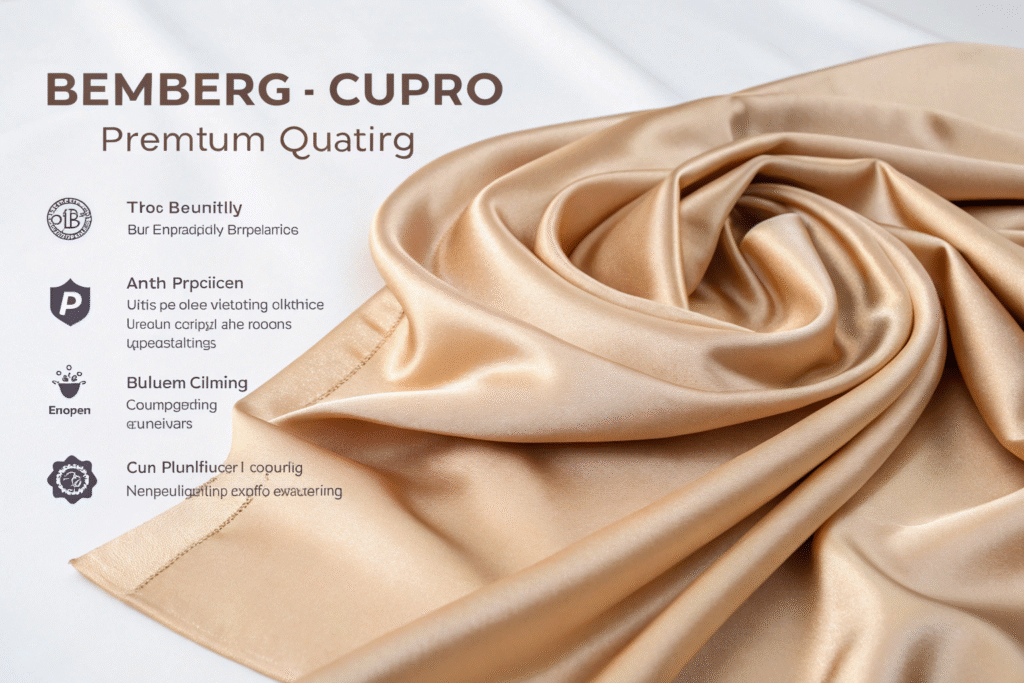
How does Bemberg cupro enhance comfort?
Bemberg cupro enhances comfort through its exceptional physiological properties. Its fiber structure is highly absorbent, able to take in moisture and release it quickly, which makes it extremely breathable. This prevents the clammy feeling associated with synthetic linings. Its surface is incredibly smooth, reducing friction against the skin and allowing outer fabrics like wool to glide over it easily. This is why it's the preferred choice for tailoring and high-quality suiting, where comfort over a full day is essential. It is also naturally anti-static, preventing uncomfortable clinging.
Is Bemberg cupro's sustainability and cost worth it?
Whether Bemberg cupro's value is worth the cost depends on your brand's positioning. From a sustainability angle, it is a regenerated cellulose fiber made from a renewable resource (cotton linter, a waste product from cotton processing), and its closed-loop production process recycles water and solvents, making it a more eco-friendly fabric choice. However, it is more delicate than polyester and typically requires dry cleaning. The cost is significantly higher than the other options. For brands building a reputation on quality, durability, and sustainable practices, this investment pays off by enhancing the product's overall value and appeal to conscious consumers.
Conclusion
Choosing the best lining fabric is a strategic decision that directly impacts your product's quality, comfort, and brand perception. There is no universal winner, only the best fit for your specific needs. Polyester taffeta is your go-to for unbeatable durability and value. Acetate offers a cost-effective solution for beautiful drape and sheen. Bemberg cupro stands at the pinnacle, delivering unparalleled breathability and a luxuriously comfortable feel that justifies its premium price. Your choice should be guided by your garment's purpose, your target customer's expectations, and your overall budget.
Ready to source the perfect lining fabric for your next collection? Let's co-create value. At Fumao Textiles, we provide all these lining options and offer expert guidance to help you select the ideal one. We ensure strict quality control, from our CNAS-certified lab to seamless logistics. Contact our Business Director, Elaine, today to discuss your requirements and request swatches. Email Elaine at elaine@fumaoclothing.com to start a conversation about your fabric needs.

